#i read up a little on colouring techniques for old comics and decided it was worth applying somewhere
Text
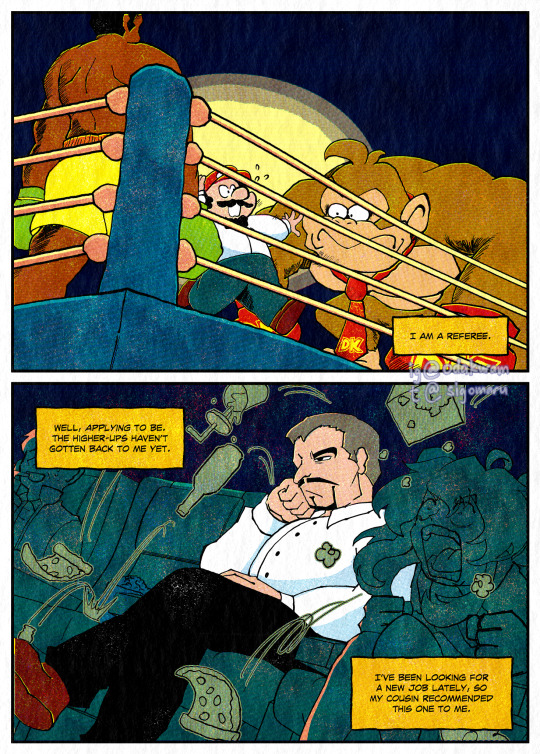
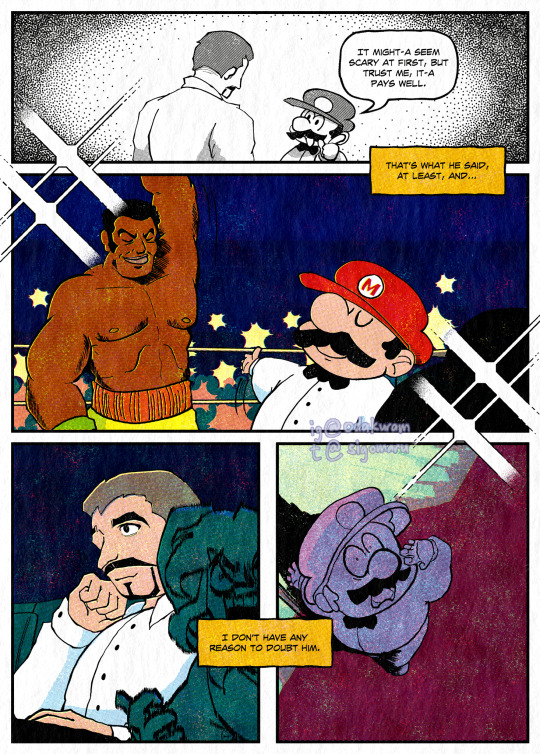
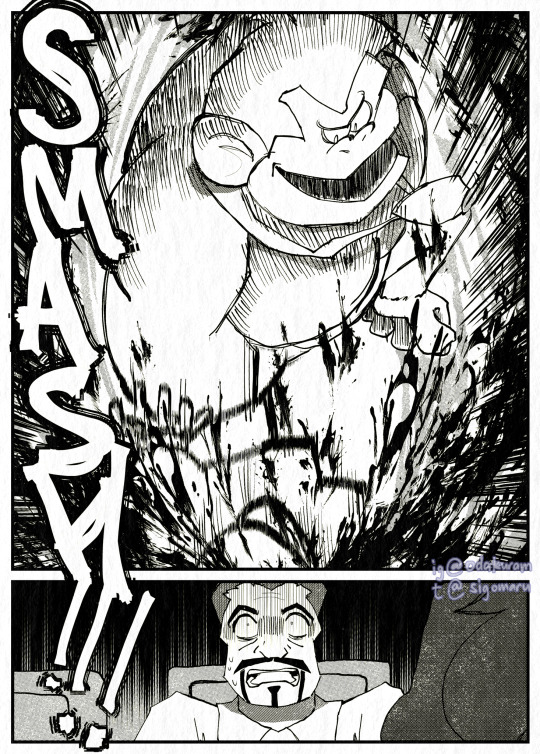
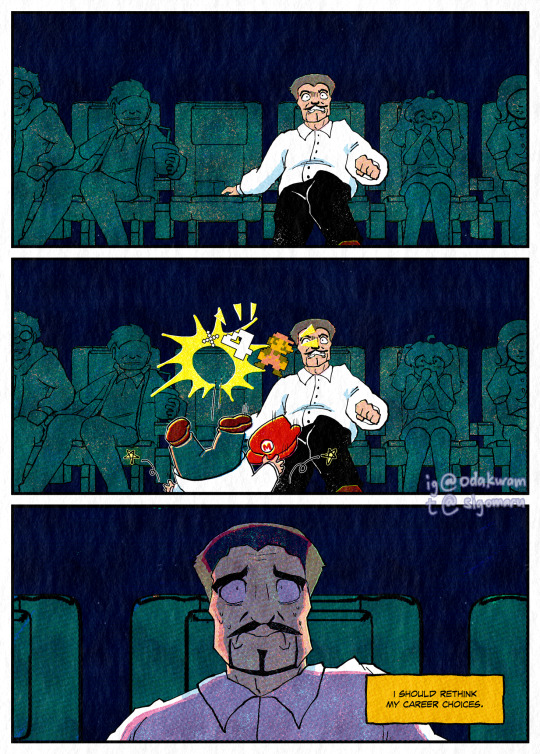
mario, the referee
#the referee#mario#mr sandman#donkey kong#punch out#super mario#illustration#digital art#clip studio paint#comic#tw blood#i read up a little on colouring techniques for old comics and decided it was worth applying somewhere
233 notes
·
View notes
Text
In hopes to attract some more attention to my works, I’m posting a preview of the prologue/first chapter of the 40k x RWBY crossover story I’m writing. A link to the thread on Space Battles Forum will be posted at the bottom of the thread.
Synopsis: Magnus the Red, revived and redeemed through means arcane and ill-understood, has migrated to the world of Remnant after aiding his father in breathing life into a dying empire. With his sons, he will prove himself to the galaxy and to himself, or he will perish alongside the world of Dust he has pledged his life to.
O.o.O.o.O
Beacon Academy’s library was not the most elegant structure—it did not need to be. It was pragmatic in its design, generous perhaps in its dimensions, however. Large, with open space allowing for room to grow its interior. Walls that were half-a-foot thick, comprised of materials that could resist the force of a Megaton Bomb, if it were to exist on this strange world.
Despite these shortcomings, it still managed to awe the students as they entered, immediately greeted by a gothic marvel, akin to that of an, albeit simple, large cathedral. The front doors were wide, comprised of dark, well-conditioned and well-made wood that could withstand the blast of a grenade without even a scratch, battened by flat steel reinforcements along its top and bottom sections, riveted with gold and brass. Above that door, arching up to converge at a single point from which a stone gargoyle would sit upon an arched outcropping, and above that stone guardian, was a window. Stained glass in the shape of a nigh-perfect circle, plagued by the imperfections of the tools at hand, but certainly not the craftsmanship. It was no particular depiction displayed in the colourful window, yet many students still claimed to see figures in its visage.
Upon exiting the foyer—entering deeper into the mighty library, dubbed the Magnus Librariae, the Greatest Library, this theme only continues. High ceilings are accented by light fixtures that mimic the silhouette of candles, even giving the faintest flicker every so often to perform its best imitations of a wicked stick of wax. Walls with grandiose architecture that was painted along the curved roof to depict many a battle from that Great War which ended some eighty years before. The murals and the stories told by them, however, ultimately serve little other than to add an air to the building, something it accomplished well. Students respected this place above all others—no fights broke out in its expansive interior. No rules laid out by the quaint, feeble old man that called himself the librarian, were ignored or disobeyed. Books were placed on shelves where they belonged, and they remained nearly as pristine as the day they were taken off the printing presses.
Among the many towering shelves of the Beacon Library, a single book, one with no fancy cover or elegant text upon its spine, a simplistic, yet exquisitely crafted, leather-backed tome, sat upon a shelf. This shelf contained many tomes like it, each one unique in its contents if not its cover, but this one, so simple among such elegantly, flamboyantly crafted tomes, had the luck of catching the eye of the first woman to read its contents in so very long.
Pyrrha Nikos, while not much of a scholarly type in her own right, could still appreciate a good book. A good pastime when one spent as many hours as her or her team did recovering from battle wounds or engaging in the oh so arduous and pressing task of simply finding peace. Pyrrha couldn’t quite place what had drawn her to decide to read upon the topic of history. Perhaps Oobleck’s lessons were starting to get through to her, learning of history, after all, is the best way to avoid repeating those past mistakes in the future. Perhaps it had been the simple cover of the tome, the black sheep among the flock of silver-coated, shimmering lambs. Perhaps it had simply been fate.
Pyrrha took the tome from the shelf, finding herself coughing as long-settled dust was released from its still place along the ill-searched shelf. A brush of her hand and the cover became clearer, the title in simple, bold font along the top sect of the book, not too small that one must bring it closer to properly read, yet not too large as to take up any amount of space wider than a young woman’s hand. On the dusty, sage cover of the historical text, read the title:
SORTIARIUS, THE LOST CITY OF THE SHARPENED DREAMERS.
Pyrrha hummed softly as she mulled over the title. A brief flip-through showed the book in fair condition, with very little wear on its pages from frequent readings like some of the more popular tomes, like that of the Faunus scholar Mitellus and his reflections on the prejudice of man and beast, or the influential military tomes of Taurus Rex that taught many of the young students the advanced combat techniques utilized by full-fledged Huntsmen and Huntresses, or even that of the popular comic series, Pumpkin Pete’s Bizarre Adventure. This one was different, different enough to warrant being tucked under Pyrrha’s arm, against the bronzed cuirass of her outfit alongside the dozen other thick books already waiting, yet still a black sheep among a sea of ebon wool in comparison to the rest.
The shelves of the library were not only tall—dwarfing Pyrrha like a grown adult man to a toddler and then some—but they were dense. Sound had issues fully traveling in some places, especially the historical literature sections and discerning one’s location had become such a crisis that electronic signs would be mounted along the narrow of the shelves in order to direct students to where they wished to go. Even such a knowledgeable woman like Pyrrha found herself using the screens to get back to the main foyer of the library, the notorious two-floored, incredibly simplistic in comparison, warmly-lit main area where students gathered at tables to study and where the more commonly-read tombs were positioned on significantly smaller shelves than their taller, broader cousins in the deep of the library.
Soon enough however, the crimson-haired girl found herself weaving out from the shelves of the library and toward the wooded balcony overlooking the humble librarian’s station, situated cozily against the wall, alongside the main tables, where she would find her friends of Ruby and her wonderful team, alongside her beloved comrades in Team JNPR. Pyrrha quickened her pace, quietly speed-walking down a stairwell off to the right before emerging from past a column which supported the stairs she’d mantled. Ruby was the first to spot her, waving frantically to Pyrrha before the rest of her friends did the same, happy to see their friend alive and in one piece after her oh-so-brave venture into the heart of the library of Beacon, plentifully notorious for having many a student get lost in its winding halls for days on end before being found.
“Pyrrha! We thought you got lost,” Jaune said to his teammate with a smile as he turned to greet her, his blonde mop of hair obscuring the upper parts of his eyes as he shifted. Nora quickly bounced up from her seat like a helium-infused rocket and hugged her dear red-headed friend.
“Haha! I’m glad to see you’re safe—and not just because Ruby and I had a bet over whether you would get lost in the library,” Nora rambled as she embraced her friend, the raven-haired tiny reaper seething quietly at her seat with a hint of amusement drawing at the corners of her lips. Pyrrha allowed herself to giggle a bit at the antics of her friends before sliding into one of the wooden chairs beside Jaune, books neatly taken from the crook of her arm and stacked atop one another. Her eyes drifted curiously down to the sage-backed book at the top, the tale of the Lost City, a story of which she was endlessly curious about now. Not once in any of her history lessons, from the youngest of ages to now, had she even been vaguely made aware of this city, this Sortiarius. It baffled her mind and tempted her as her fingers graced the ribbed spine before gently taking it into her right hand, pushing softly the heavy stack of tomes off to the side in order to make room for the one which now held her full attention. Flipping it open to the front page, she was met with the author’s name and the opening words. She read the words in her mind after taking a deep breath.
‘It is in this tome that I, Helio Kalliston, noble orator of the final dynasty of the Redguard Guild of Serfs and Peasants, enclose the fullest history of the noble city of Sortiarius, from its earliest days as a result of colonization turned to migration by the various nations of the time, to its final days, collapsing at the hand of the damned Grimm…’
Pyrrha was quickly sucked into the elegant words of Helio Kalliston. He described a city borne from the ashes of apocalypse at the hands of Grimm, forged by the ancient and venerable Crimson King, a towering giant of a man who wielded the very weather in his own hands as he led his people from all the way in Solitas as the tyrant-kings rose to power, all the way across the ocean and through many villages, saving those they could from the rampaging hordes of Grimm that followed the melancholic band of knights that followed the King, whose powers were legend among the descendants of the Sortiarians. One story described a knight in full plate that carried the very hand of the righteous God of the Sun along his right arm, melting Grimm with beams of glowering orange heat, whilst the snarling, hateful axe of the God of the Underworld was clasped in his left, using these weapons to strike down any, man, woman or Grimm that dared stand in the way of him and his King. The legends enraptured Pyrrha like few things had done before—the harrowing tales of a city being forged from the fires of a Grimm-infested forest filled her with excitement, whilst the tales of the many dynasties of the philosopher-kings thrilled her, before saddening her upon their deaths upon the eve of long-gone centuries past. Pyrrha had no concept of how much time had passed as she fingered through the pages of the historical literature, allowing the outside world to bleed away until it was only her and the fated words of Helio Kalliston, the final orator of Sortiarius and its dynasties before the city’s destruction, described in the final words of the tome, written in by a second writer who included what Helio could not in the final manuscript. To think that any of this could have possibly been true, even if exaggerated, amazed Pyrrha. She lamented thoroughly how dozens of other records were used to cross-reference and act as intellectual sources for the knowledge of the tome and, though it was long, it seemed almost hollow. Reading the ending sentiments at the back revealed to her the unfortunate truth—that the tome was meant as the summary to a longer line of historical records which would cover in detail the many aspects of life in Sortiarius, from the socio-political battlegrounds to the innerworkings of the nigh mystical Redguard, the angelic warriors who defended the city to the last man, woman and child, the incorruptible few among the fallible many. How she would love to sink into the past and simply see what it may have been… however her fantasies were cut short by a nudge from Jaune. Promptly looking up, Pyrrha found the eyes of their table entirely on her. Cheeks flushed and quietly turning to Jaune for an answer, she sputtered out an embarrassed excuse to her silence.
“I-I’m sorry, I was so enraptured in my reading I didn’t even hear you if you were speaking to me.” Jaune smiled and nodded in understanding.
“I know the feeling. Those Pumpkin Pete graphic novels always have me glued to my seat!” The wholesome smile on their naïve leader’s face was something to be appreciated when it showed, Pyrrha had learn to do as the naivety—or perhaps innocence—of Jaune was enough to bring joy to both their teams in ways that would become scarce in their later years. This moment was no exception, giggles spreading across the table before Pyrrha responded.
“Well… While I can say that I’ve read those, albeit for a children’s charity some time ago… this book is one I don’t think I’ve ever heard of,” Pyrrha spoke with curiosity mixed into her tone, bringing forth that same emotion from her fellows.
“That’s so weird! You’re like one of the biggest bookworms I know, how have you not read this one?” Nora asked loudly as she came in close to her Mistralian comrade, the girl rocking backward to compensate for the distance lost between them.
“Well… I don’t know. It was in the historical section in the deeper parts of the library. It talks about an ancient civilization that was around before any of the four kingdoms, called Sortiarius.” Pyrrha explained the book in simpler terms to her younger and more… immature friends.
“It was this city that existed, well, we don’t know how long ago, but the footnotes suggest thousands of years ago! They were a kingdom, well, closer to a city-state, but they were a big one. Their government was a complex bureaucracy guided by mentor-figures called ‘The Philosopher Kings’ who ruled over the city. According to this book, they had mastered the art of using the soul as a tool that they could perform minor acts of what they considered sorcery. Although, I’m not so sure if that last part is real… ultimately it wouldn’t matter all that much, their city fell to the Grimm and internal strife long before even Vale was around,” Pyrrha explained to the best of her ability. While it wasn’t difficult in by any definition of the word, it certainly wasn’t simple by any means either. She had barely gotten through the first three chapters and it had been at least an hour. She let out a minor huff of irritation as she stared down at the book—as interesting as it was, she didn’t have the free time in any week to reliably put in enough time to read and retain whatever information could be gleamed from the book. However, judging by how the weapons were described in those opening three chapters, she had a fair idea of who might find better use of the book.
Pyrrha Nikos flipped the book shut and stretched out her arms before turning her gaze to the young, raven-haired red reaper.
“Ruby, you love weapons… you should read this. The Redguard—the city’s defense force, huntsmen of the time, they used some of the most advanced-sounding weapons I’ve read about, guns that fired some sort of energy and something called a ‘chainsword,’ among other things.” She placed her hands over the book and thumbed the cover as she asked, admiring the simplicity in the design for a moment before her eyes caught Ruby’s own orbs turning to saucers.
“Chainsword? As in a chainsaw-sword? Guns?! What kind of guns?! Sniper rifles? Shotguns? Pistols? Automatic weapons?! I demand to know moooore!” Ruby all-but belly-flopped onto the table as she got close to Pyrrha and the precious book, hands reaching out to snatch it, though the fiery-haired champion tugged the ancient tome back before her young friend could snag it.
“This book is very old, Ruby, be careful with it.” She was prepared to lecture the girl slightly, though feeling that was more the white-haired ice queen’s—as the rowdier students had nicknamed her, rather rudely—job than hers. The pouty face given by Ruby had not helped much either.
“I will! I promise,” Ruby said softly upon Pyrrha bringing the book closer. The younger girl took the tome in her hands for a moment and did the same as her compatriot—just finding a moment to admire the simple design, where so many others were elegant, vain and loud, this one was… humble. Quiet, soft-spoken. It knew that what it contained was worthy of her eyes, it was confident to such a degree that it did not need such a vain and flashy cover. A simple, leather, sage-green cover with neat, lightly-coloured, tall and bold font to display its title and the purpose of the tome. Something about it relieved Ruby’s mind as she took the book and scooted back into her seat. She slipped it into her bag after a moment of contemplation longer and refocused herself on studying.
Some hours had gone by, studying, socializing, and doing the part of students as best as could be expected of them. Eventually the sun grew tired and dipped below the horizon, allowing for the fractured moon of Remnant to rise in its place. The students, having spent their day studying, were unified with the sun in their exhaustion. So, after a long day of studying, the two teams separated from one another, said their goodbyes, and retired to their dorms. Whilst most members of the teams were quick to lay their heads to sleep, there was one outlier among them.
Through the darkest hours of the night and to the early morning of the next day, Ruby sat at her desk and poured over the tome. Vast in density with its glorious renditions of battles between the mystical Redguard, towering giants that were rumoured to be ancient half-automata half-man, and the darkest and most formidable forms of Grimm that Ruby had ever seen depicted. Real or not, the images were nice to look at and that was where most of her time was spent, for despite the thickness of the tome, it still bore little content. Pyrrha’s assessment of the book had proved painfully correct, as it referred to so many dozens of other books that were likely long gone.
Her hunger for knowledge, always satiable, overwhelmed the young raven-haired reaper and she found herself redressed and quietly sneaking off to the library in those dark hours of the early morning. As she came to those huge oaken doors, Ruby paused.
Would the doors be locked? Would this all have been for naught? No, she would get her answers. Did that mean breaking in? Or did that mean waiting till morning? There were classes and countless trainings the next day, she wouldn’t get a chance like this again. But what if she was caught?
Her endless tirade of paranoid thoughts was stopped when the doors slowly creaked open, startling the girl as the humble librarian quietly pulled the door open and stared at her. He was hunchbacked ever slightly, wearing a brown robe that enclosed a thin body, while frail, had once been muscular and built like brick and steel. His face was wide, likely statuesque in his youth, but years fighting had scarred his face and old age wrinkled the once handsome features.
“You should be in bed, young one,” he greeted quietly after a brief staring contest that might have lasted a few seconds too long.
“I-I know, but I read this book and I just wanted to know more-!” Ruby began to explain in a lapse of mild panic, only for the librarian to raise a hand to silence her as he spotted the ancient tome in her hands.
“I am not one to judge the practices of those seeking knowledge… Gods know that would make me a hypocrite,” he opened the door fully and beckoned the young Ruby Rose in. The library was quietly lit by golden candlelight, the dim flickering shading the librarian’s face in soft yellows and oranges, highlighting the scars along his left cheek, burns, cuts, gauges in the wrinkled flesh. It intimidated the girl a moment, but the knowing smile invited her into the expansive library, and she took the offer gladly, clutching the sage-backed tome in her arms as she entered Beacon Library, the door closing behind her softly.
Soon, Ruby was sitting with a small stack of disappointingly thin tomes that could barely equate to the width of the historical, sage-backed volume, but it was enlightening, nonetheless. A cup of steaming tea sat at the opposite side to the books, on a ceramic saucer. Across from her, sat the librarian, pouring over a quiet-looking book. She shifted in her seat for a moment and waited to see the reaction from the old man across from her. When none came, she sat her head on her hands and sighed exaggeratedly. No response. The young reaper wriggled in her chair for a while before she couldn’t take the silence anymore without books to pour over.
“I still can’t believe that this place used to exist,” Ruby blurted. The librarian peeked up from the book he was reading, raising an eyebrow curiously.
“You’re unsure of the truth,” the librarian spoke softly as he closed his book, sliding it to his left. Ruby hesitantly nodded.
“The way they describe the weapons and these drawings, they just seem… unreal. Like something out of a fantasy book. They said the one captain, Hastar H’Kett, he had a weapon that was like… some kind of lance of orange light and all the pictures show him doing all this crazy stuff—it just… it feels more like a legend than ancient history, y’know?” Ruby ranted rapidly, red-faced and rosy as the old librarian stared at her with an amused expression gracing his features. He folded his hands together and sat them in front of him as he began.
“Well, I can assure you. This,” he pointed to the book, tapping its cover with his index finger, “it is our history. Remnant’s history. Some of those images were… exaggerated, but I can tell you that they very much had weapons like how those flowery words describe.” He grinned as Ruby became bemused at first, her forehead scrunching as her eyebrows furrowed and her eyes darted back and forth in thought.
“It… they’re not lances. They’re guns. But… how could that be possible!?! No Dust weapons could even accomplish stuff like this even now!” Ruby asked incredulously. In return, the humble librarian laughed softly, tapping a hand gently to the table, understating what would be a symbol of exaggerated laughter. Perhaps it was a sign of his age catching up with him, making him more soft-spoken. Perhaps it was simply an action to be amusing to the young student, a goal he readily achieved as Ruby tittered at his antics, something that brought a smile to his aged facial features.
“Well, I can at least tell you a story. Something passed down in my family… it all began in those olden days when most men fought with spears, swords and axes. Not the Sortiarites, they used majestic automata and weapons the like of which would never be known again…”
O.o.O.o.O
SB Forums thread:
#fanfic#warhamer 40000#rwby fanfiction#rwby#scifi#writing#warhammer 40k#40k#fantasy#crossover#RWBYx40k#Magnus the red#thousand sons
11 notes
·
View notes
Text
Hey everyone! I hope everyone is doing okay with what’s going on. I’m glad that there are spaces like this where we can all still “gather” in a cyber sense. I just wanted to write a quick message to say that I hope everyone is staying safe and doing what you can to keep others safe as well. It’s scary, I know, everything is changing and really uncertain and confusing but it’s important to just take a deep breath sometimes and remember that though this needs to be taken seriously, it will pass.
For those of us self isolating (I’m fine but my uni cancelled all class and moved everything online last week so I don't really have anywhere to go anyway and it all helps flatten that curve) I thought it would be good to come up with some ideas of things to do if you’re bored out of you mind. I’ll start a list and everyone can add on some ideas
First, just a reminder to anyone else in my position finishing or continuing a semester online to stay on top of your studies and assignments. Get your education along with your degree. If you feel like you’re struggling with whatever your educators have decided with your education, reach out to them. I’m sure they’ll understand how tricky this can be (and if not, fuck em).
Take the opportunity to write, write, write! (what did you expect from this blog? :p)
Or read! If you don't want to go to a bookstore or your libraries are closed this is a reminder that some libraries have ebook loan options where you can have access to downloads from your own device!
Puzzles or board games. Maybe learn some new card games from online?
Learn some new recipes or cooking techniques. Maybe try a new ingredient if you can or play with revamping some left overs.
Learn to sew or knit if you have supplies.
Start learning a new language?
Watch some documentaries or find a cool new podcast (suggestions welcome!)
Maybe go full Marie Kondo and do a nice clear out and organize your space (while listening to some new music, podcasts, or playing some YouTube videos, TV etc,)
redecorate. Maybe you can't go out and buy a whole new furniture set but maybe you’ve been meaning to move that dresser or you can rearrange some posters or hang up some photos
Try some at-home yoga or other home workout things. I think especially since we’re being encouraged to stay at home we might be sitting too much and not moving enough which won't be healthy and might cause some aches. (Especially as writers we have to remember to take a few breaks away from a screen!)
Do a fashion show for yourself. Go through your wardrobe and see if there are some cool new outfit combos you can come up with that are a little outside your comfort zone. Or play with makeup and try some bold makeup looks or techniques. You’re stuck at home anyway so it’s not like anyone is going to see you so now is the time to break out that super cool shirt or break out the teal eyeshadow that you’ve been too shy to wear out and maybe once this is over you’ll be like fuck it, I killed it.
Try some new arts or crafts projects or techniques. Paint something silly. Draw that comic you’ve been thinking about. Try some nail art. Play with that old construction paper at the back of the desk. Make a paper dragon and colour it in. Make a lego castle for your dragon to attack.
Skype or send some messages to people that you need to catch up with. Maybe you have family or friends abroad, maybe just a quick check in to see how they’re doing
59 notes
·
View notes
Text
A-Level Playing Field
Nobody wanted my opinion on this, but it’s hard growing up poor.
1988. It’s that damp kind of evening outside, clouded by condensation on the single glazed windows, and the smoke from my Nan’s Benson and Hedges. We’ve just had tea – this is North, of course – and everything is accompanied by slices of springy bread heavily lacquered in ‘soft spread’. The gold foiled butter is, usually, saved for my grandad, who works at a fibreglass factory. It’s a very long way away (actually 3.7 miles) and he leaves on his bike every evening with three rounds of tinned ham sandwiches in his bag. Tonight, my mum is out until half nine, working in the care home in the next town, picking me up at ten-ish, depending on how fast she walks. My mum is 27. Five years out of a loveless marriage, living in a council house, she has no qualifications but is working for her City and Guilds and her English ‘O-Level’, GCSEs haven’t hit our vocabulary yet, and won’t until my second cousin Mark does his two years later.
Tonight is Thursday. Nan goes out on a Thursday, which means she will leave the house at half seven in a haze of Vitapoint, Elnett and Lily of the Valley, to play Bingo at the local club. I am being looked after by Alan, my mum’s younger brother, living at home, working in the Mill that overlooks the town below like a stern Victorian overseer. He’s always grumpy, stuck in a town that has no opportunities, and no visible exit. The eighties have been cruel to young, working-class men. The vehement cry of ‘get the fuck out’ hasn’t reached our town but will do in eight years time, on a wave of Britpop, New Labour, cigarettes, and alcohol.
My uncle looks to the television for nightly escape. Thursday is Blackadder, it’s Not The Nine O’Clock News, it’s Comic Strip, it’s A Bit of Fry and Laurie, it’s Red Dwarf, it’s shipwrecked and comatose, and me engrossed on the couch, not sipping mango juice, but milky tea (the North!), as my uncle laughs his head off in between cigarettes. My mum returns, smelling like TCP and the outside, with salty, vinegary chips, and we eat them as we walk the newly tarmacked paths under the orange street lights. I ask her what a goldfish shoal is. She tells me to shush.
I decided that weekend that I wanted to be funny. I mean I could make people laugh when I did my Cilla Black impression, so surely that was a start, and thank to Carry On films I was brilliant at ‘Infamy, Infamy!’, I knew this because my grandad (the cleverest man I knew) had told me so. Even though I was only in Junior One, I knew that you had to be taught how to be funny, that there was definitely some kind of class that you would have to take to learn it, because I had never really been a natural at anything; apart from whistling, which I did with gusto in shrill, high- pitched tones wherever I could.
I read a lot, especially the paper – particularly the Daily Mirror, which probably explains why I am always heavily weighted to the left, and not just because of my ineptitude in heels – and found out that Hugh Laurie, who is obviously the funniest man I have ever encountered, went to Cambridge and was in something called ‘The Footlights’. Then was it, I decided. I was going to go to Cambridge and join ‘The Footlights’ and be funny like Victoria Wood and Dawn French. I imagine ‘The Footlights’ to be a rag-tag theatrical group living on their wits, humour, and more importantly, Pot Noodles. I tell my Grandad that I want to go to Cambridge. He tells me not to be daft.
Now, when I think about it, wanting to go to Cambridge was not a preposterous idea for any child at the age of seven; you are at the start of your education journey. There is plenty of time to get better at things, to practice, to be coached, to improve yourself; but for a working-class girl, who would eventually be the first member of her family to go to university, I might as well have said that I wanted to fly to Mars on fairy wings. But, children who attend private schools are told from the age of four that Oxford or Cambridge are the end goals for their education, with any of the higher-performing Russell Group universities being something that they could settle for, at a push. I didn’t even know what a Russell Group University was until about three years ago, and why would I? For me, in my small artsy primary school with forty children across four year groups, a dismissive attitude towards formal English education, and a liberal fancy for devoting the whole of the summer term to the end of year show, this was not something that was even thought about. Oxford and Cambridge were places printed on the back of books, they weren’t places that you went to university. In fact, most of my primary school teachers hadn’t even been to university but received their qualifications at the local teacher training college; the only exception is a brown jumpered gentleman with a penchant for using cupboards as a disciplinary technique.
We’ll skip forward a few years later, and high school is a vigorous mixing bowl of talents, it takes until at least year nine before anyone even notices who I am amongst the squall of kids churning about in KS3. Dinner is pink sausage meat wrapped in a translucent puff pastry duvet, a treat even on the hottest days when the fat sticks to your lips; and the terms pass in a haze of cheap cider (the kind that tastes like sick), the floral pout of Cherry Lypsyl, and Chris Evans on the Radio One Breakfast Show; who is hastily snoozed every morning before I smell the lukewarm coffee my mum has left by my bed before she goes to work. At this point my mum is a newly qualified nurse at the hospice two towns over, her fingers raw from hand sanitiser, but with rolls of antiseptic scented micropore tape that I use for a cacophony of projects. She is on nights right now, spooning gravelly granules of instant coffee into a mug, blurry from sleep, I am cobbling together a mask out of old Cornflake packets, stuck together with nursing supplies and painted with nail varnish that went past its best around the same time as the Thompson Twins. It is 1995, and the country feels like it is on the cusp of something. I don’t know what, but I’m looking forward to the Year 2000 because I will be fully grown. Well, nineteen.
But what about Oxbridge? Well, for starters, if you attend a state school you have to be so immediately impressive to your teachers that they discuss you in the staffroom. It’s not enough to be good at one particular thing, you have to excel across the board. You have to be so amazingly shiny, that even the most jaded teacher in the school cannot fail to be dazzled by your brightness. For state school kids, Oxbridge is not something that they suggest to the average 10 A*-C kids, it’s not something that they even dangle in front of 10 A*-B kids who are pretty good. At state school, you have to be exceptional for your teachers to even consider you as a candidate, and then you have to achieve enough A*s in your GCSEs that you might as well open a Planetarium. Even then, all they can really do is say ‘I think you could go to Oxford or Cambridge, you know’, or flag you up to the local authority careers service as ‘potential Oxbridge’. There is no Oxford Fast Track programme in state schools, even for exceptional kids.
In a recent social media fracas, one lady proclaimed that if you gave kids a level playing field then poor kids would always triumph because they were more resilient - all those Crispy Pancakes, surely? But for children from a working-class background, we’re not even on the playing field yet; we have to borrow trainers with non-marking soles, scrape around for a quid for the bus. By the time we get to the playing field, we have already been running around for half the day trying to get there, we miss the warm-up because we were late and, honestly, by this point, we’re just knackered because we’ve had to work so much harder just to get there in the first place.
The warm-up is a given to those whose parents have been able to pay for their education – they even get complimentary orange slices for afterwards, just for extra pep and vigour. There are Oxbridge prep classes, extracurricular activities slanted towards the Oxbridge admissions interviews, and chances to take unpaid internships during the summer using family connections. It’s not just that though... it’s little things like knowing it’s pronounced ‘Barkshire’, not Berkshire, it’s when you use a napkin, it’s spending a week skiing at Courchevel. It’s olives.
In 1998, I don’t know any of these things and, even if I did, my accent with its flat vowels and its Lancashire intonation would give me away in a heartbeat, because I sound like I’ve fallen off a pit pony on my way back t’mill. Things change quickly though. My mum has a baby. A screaming, mewling little boy born during The Simpsons on a Friday evening in October. Now there is absolutely no money for luxuries, and when our TV gets nicked, we end up using the small portable from upstairs. My Nan lends me money here and there to get to college, but it only covers the bus fare, and the small endowment that I receive - supposedly to cover driving lessons - gets swallowed up with everyday things that seventeen-year olds shouldn’t have to pay for. I’m working for 4 hours a week in Woolies too, £3.10 p/h to stand around the toy department in a slippery polyester blouse the colour of synthetic mint ice cream, before skulking off to the bookshop to spend that money on things for college. Nothing fancy but, by this point, I am well on my way to being a ‘Funny Girl’, studying a raft of ‘arty-farty’ A-Levels and English thrown in for good measure. The Cambridge Footlights hardly crosses my mind anymore, because Oxford and Cambridge are reserved for the kids doing the hard sciences, maths, law, politics, things that you need a calculator for. You don’t get into Oxford with A-Levels in Theatre Studies, Media, and Performing Arts, despite what they tell you about diversity.
Oxford or Cambridge do not offer a typical British university experience, and how can teachers who have never passed through the rigorous and exhausting Oxbridge admissions procedure be expected to offer any kind of advantage to their gifted and talented students? If you are a working-class parent relying on underfunded, underpaid and overworked FE lecturers to help coach your child through this, then you are immediately on the backfoot compared to a child whose parents can afford private tutors, admissions booklets, and interview coaches. This is no reflection on sixth form teachers in FE establishments across the country, who do all they can to nurture the kids with Oxbridge potential, but when some classes haven’t received new textbooks for two years, where students are encouraged to photocopy their own materials to save costs, you can see where the class difference begins to draw attention to itself without the need for neon yellow highlighters.
My UCAS book arrived in September; an impressive, thinly papered tome with a glossy black and white cover, University Colleges and Admission Services stamped across it in orange. It smells like a cross between the Argos catalogue and a phone book, which I feel is rather apt given that it contains the codes of institutions and courses that will break me out of this godforsaken town: a cypher that I etch out on the application form in black biro.
London
Southampton
Buckinghamshire
Preston
Liverpool
Manchester.
I don’t want to go to any of the bottom three, of course, far too close to where I came from to be relevant. My second cousin Mark’s stint at Sheffield Hallam seemed to be an excuse for his mum to visit his ‘digs’ once a month with catering sized tins of Nescafe, and I would be lying if I said I wasn’t quite looking forward to edging the lid off with a knife and stabbing through that ridged foil. My mum writes a cheque out in her secondary modern handwriting, crossing her fingers that they won’t cash it until after payday.
The discrepancies between low-income working-class families and those with a better income also show here too - this can be something as simple as slow internet connection, not having a working laptop and doing work on smartphones, access to transport, costs for travel to visit universities. Things like this are not included when factoring in costs for students from low income. How can you visit all the different university campuses, with all the travel costs and maybe even overnight accommodation, when your parents can barely afford to keep the lights on? There was only one institution that I wanted to go to. London Institute, a glamourous collection of art colleges that included the London College of Fashion, Central St Martins, and, more importantly for me, The London College of Printing. The competition was fierce, but I was shortlisted for an interview in the capital with a former editor of the Daily Mirror. My house was showered in happy expletives that day. Even in 1999, tickets from Wigan to London were over £50 for a pre-booked return. My mum cashed in all of her Clubcard points for the ticket. But, just for me, because she hadn’t bought enough milk to cover the cost of two tickets. However, I must have impressed Tony Delano in that office in Clerkenwell, because he gave me an amazingly lowball offer meaning that my A-level results became a terribly graded self-fulfilling prophecy.
Oxford is different from usual universities in that there are colleges, thirty-nine in total. You might have seen them on University Challenge – Balliol, Trinity, Emmanuel, Brasenose – or from reading the Wikipedia pages of any of our last three Prime Ministers, including the incumbent Boris Johnson, who graduated with a 2:1 in 1987. That’s the other thing – you don’t study something at Oxford, you read it – you don’t start your studies, you matriculate, for which you need a robe. Now, I have been told by helpful and obstinate alumni via social media that Matriculation Robes are £25, ex-hire. However, I have also been told by a current Oxford student that the robe cost is £50 minimum, and no-one would dare wear a secondhand robe as ‘everyone would know’. It’s immediately singling yourself out as a Weasley in a room filled with Malfoys.
The accommodation costs are comparable to London prices; however, this does not cover the Christmas break, which means everything needs to be packed up and stored. Not only do you pay for the storage, but you pay for the boxes too. Much to my disappointment, no-one nips out for a Pot Noodle either, students are expected to dine ‘in hall’ (again, more cost!) where you can choose between an informal and a formal sitting – where your gown is required. I imagine for a working-class kid attending Oxford or Cambridge is very much like cosplaying on a Harry Potter set, but without the magic of a bottomless purse. There are balls too at the end of each term, formal affairs with ticket prices over £50. Again, said the former alumni, you don’t have to go! It’s not obligatory!
But let me tell you a harsh reality. Nothing ostracises a poor kid more than not being able to join in because they can’t afford it. Nothing. And we might have great friends who would all chip in and pay for our ticket, or lend us the money, but there is something very working-class about not wanting people to know that we can’t afford it. Surely we should not be asking these young adults who have studied and worked against all odds, to have a second class university experience because they know their parents won’t be able to help. You can’t even get a job to supplement your income either; the majority of colleges stipulate this, and as someone who had to work two term-time jobs at a much less prestigious university to live (even with the glorious student overdrafts of pre-austerity Britain), this really hit home at how much I would have struggled financially if I had gone to either of these institutions.
Recently my daughter applied for university. We get in the car and visit a university each week, driving miles up and down and across the country. We fight over choices and analyse each course based on employability, and whether or not she would like it. The process is completed in clicks and feels much more clinical than twenty years earlier, but rather than heading into unchartered waters, I have a map. It might be old and tattered, but I have a much better idea of where we are going now. My daughter believes that the meritocracy is a lie, and she tells me this in sharp, pointed tones as we receive her A-level results on a rainy Thursday morning. She goes to University in September and spends the autumn sending me videos of the Minster, or tutorials on how to swear in Japanese. She is only the second person in our family to continue on to higher education. I don’t just mean in her generation. I mean in total. We are the exception, not the rule.
One of the first questions someone at Oxford was asked by a fellow student last year was ‘private or state’, she replied ‘private’ and was met with a smile. There was no need to ask who the state school entrant was, as she queried the partridge and asparagus served for dinner – ‘this chicken is tough. Is that grass?’- and arrived for the formal sitting with her gown covering a denim skirt and shimmery top underneath. Private school teaches these things, no desperate faux pas for Isobel or Jeremy, whereas state schools do not have the resources or the knowledge to run classes on etiquette for the small number of their students that make it through the intense application procedures. This is not saying that low-income children should be discouraged – not at all – instead, it is saying that there is something inherently wrong with the system. At private school, you are disappointed if you don’t get into Oxbridge, whereas the state school child who gets in is an extraordinary anomaly talked about for years in hushed tones of reverence by the faculty.
And this is the issue with saying that children are on a level playing field, that everyone is measured on their own merit; because it is not true. For children on very low incomes, the odds are unfairly stacked against them, and the issues such as 2020’s disastrous A-Level results just add more bricks to an already near-insurmountable wall.
7 notes
·
View notes
Text
Jérémie Fischer & Jean-Baptiste Labrune
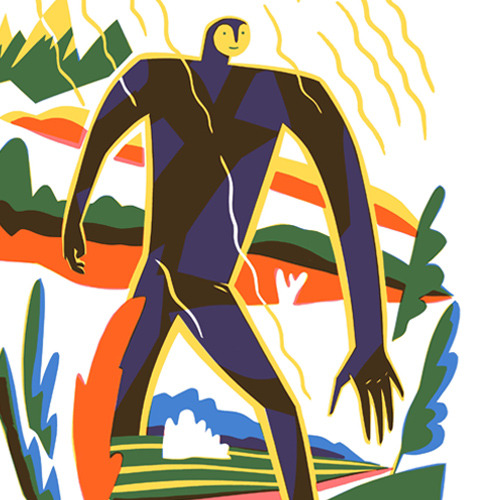
In this post, Jérémie and Jean-Baptiste talk about the creation of the excellent ‘Les contes de petit duc’ (Little Duke’s Tales), their latest book together with French publisher Éditions Magnani.
Visit Jérémie Fischer’s website
Visit Jean-Baptiste Labrune’s website
Jérémie: ‘Les contes de petit duc’ (Little Duke’s Tales) is the third book that Jean-Baptiste Labrune and I have published together with Éditions Magnani, after ‘L’éléphouris’ (The Elemouse) in 2012 and ‘Le veilleur de nuit’ (The Night Watchman) in 2014.
It’s an illustrated book like ‘The Night Watchman’ (similar formats and both about 200 pages). But this time, the book is structured around four origin stories and a prologue and epilogue. ‘The Night Watchman’, you might know, has 7 chapters: 6 nights and 1 morning of a single week.
JB, what made you want to use a fairy-tale structure for this new book? What is your relationship with tales (this is a narrative form you used in your first book,‘The Elemouse’)?
Jean-Baptiste: It’s hard for me to say exactly how the structure of a long-form piece of writing takes shape. I go by trial and error, blindly, no plan. Then a narrative appears, I work with it, I think it’s done. Then I come back to it, and it’s all wrong. I carry on, for better or worse and a new structure emerges, sharper, subtler. The coming and going between writing and structuring can happen five, six times. Maybe more. It’s as if the text already exists, but it needs to be drawn out of me, bit by bit, little by little.
Regarding Little Duke, I remember having written some tales in 2011 – or more like poems in a very neat Baroque style. The ancestor of Little Duke featured in these. He didn’t have a name (not that name, anyhow), it was a kind of monster with three pairs of eyes rolling all over the place, who lived in a very scary forest. Then the character of an old wanderer (who became Chèms, the other main character in ‘Little Duke’s Tales’) quickly took form. I gradually realised that what interested me wasn’t the fantasy or the lexical complexity (I was entering a phase where, after ‘The Night Watchman’, I was looking to refine my language and aim more for concision), but these two characters and their relationship.
So I set to work on the two accomplices. I worked out what they had in common, what they didn’t, the images and themes associated with them. That’s how Chèms and Little Duke got their own names. Their traits were honed to become complementary to one another. I wanted a lively style, punchy, with something prophetic to it. So I dived into sacred texts, those of Miguel Angel Asturias, Khalil Gibran’s poetry, Serge Pey... and I wrote ‘Little Duke’s Tales’. The framework was in place: Little Duke would have to tell stories to Chèms.
The idea for origin stories set in quickly. In fact, I seem to have written the first story more or less straight after the prologue. I returned to a long-term reading obsession of mine (already explored in ‘The Elemouse’): Egyptian, Greek and Scandinavian mythologies, which I’ve loved since I was little, and then the authors I read later: Cyrano de Bergerac, Swift, Kipling, Tolkien and Michaux. The origin story gives a very simple temporal narrative structure (one time, one day, since this day). From there, one has total freedom; geography, characters, images, languages, everything can be re-imagined. At the same time, the rigid time frame of the origin story also allows for a social or cultural critique. It’s about requestioning the world as we know it, just seeing it as a simple contingency.
Next, with the tales, it’s possible to work on them serially, like in ‘One Thousand and One Nights’. I had my narrative, so it would be enough to make a coherent collection (or so I thought), to just put the stories one after the other. But very quickly, I found myself with so many tales – long endless lists of “why?” – and it wasn’t going anywhere. The world I had built was faint, blurry, tired. Little Duke and Chèms were buried under an abundance of stories; they weren’t characters any more, just a slightly useless narrative trick.
So I decided to settle on four stories, which are based around light and darkness, waking and sleeping, the passage of time. At the same time I established how the relationship between Little Duke and Chèms would evolve as their dialogue continued. The structure was in place. I wrote the second tale. And then the third and the fourth, and finally the epilogue. After that, it needed adjusting, editing, tightening up. Then I had to think about the text with images: remove repetition, adapt the ellipsis ... There Jérémie’s work became essential, but that’s another story!
Jérémie: I went through many successive stages with illustrating the stories. Starting with trying out many different possible relationships between image and text, I wanted, at first, to work with a written manuscript and few images. In 2013, we had published our first story ‘Why is night black?’ in the first issue of a magazine called Pan, which JB and I looked after and which was edited by Julien Magnani. That was the early stages of the book, with a few ink images to go with the text.
But I wasn’t satisfied. I found the result too sensible; the text and images spoke to each other, but everything stayed in its place. Some years passed; I let the project mature in a drawer, taking it out regularly to work on breaking down the text and the book as a whole.
In 2017, something clicked. I was especially interested in Czech illustrators like Josef Čapek, Květa Pacovská and more recently Jiří Šalamoun. Also Kurt Schwitter’s two books, ‘Fairy Tales of Paris’ and ‘The Scarecrow’ (Die Scheuche Märchen), published in 1924 and 1925 respectively. I was fascinated by the freedom of colour and composition used in these different books – like how Čapek used typography as illustration on many of the book covers he produced.
At the same time, Jean-Baptiste had just written a funny little story, ‘Bululú’, very like Schwitters’ stories. I immediately got hold of it and it was published as a special edition with Pan in 2017 – a small 16-page format, 180 copies printed. From a graphic point of view, ‘Bululú’ is the prelude to ‘Little Duke’s Tales’. You see here the choice to use typography as illustration, to play with it on each page in a new way.
One year later, in July 2018, ‘Little Duke’s Tales’ was finished.
I chose the same printing technique for this book as with ‘The Night Watchman’. That is working with colours separately whilst drawing on carbon copies and using inactinic paper, constructing the image with successive sheets. We used 4 spot colours for the whole of the book.
Illustrations © Jérémie Fischer. Post translated by Gengo and edited by dPICTUS.
Buy this picturebook
Les contes de petit duc /
Little Duke’s Tales
Jean-Baptiste Labrune & Jérémie Fischer
Éditions Magnani, France, 2018
Chèms sees and hears everything. He is a wise man. But Chèms starts to wonder about the reality of his wisdom. One night, Chèms meets an owl called Little Duke, who claims to know the answers to all questions.
Chèms asks Little Duke the questions he’d always pondered: Why is the night black? Why does the moon shine? Why do we dream? Why do we age? Little Duke answers Chèms’ questions in the form of tales, beginning with the tale of the giant Aketopiou, to tell the origins of the day and the night...
4 notes
·
View notes
Text
Deathstroke Inc. #1
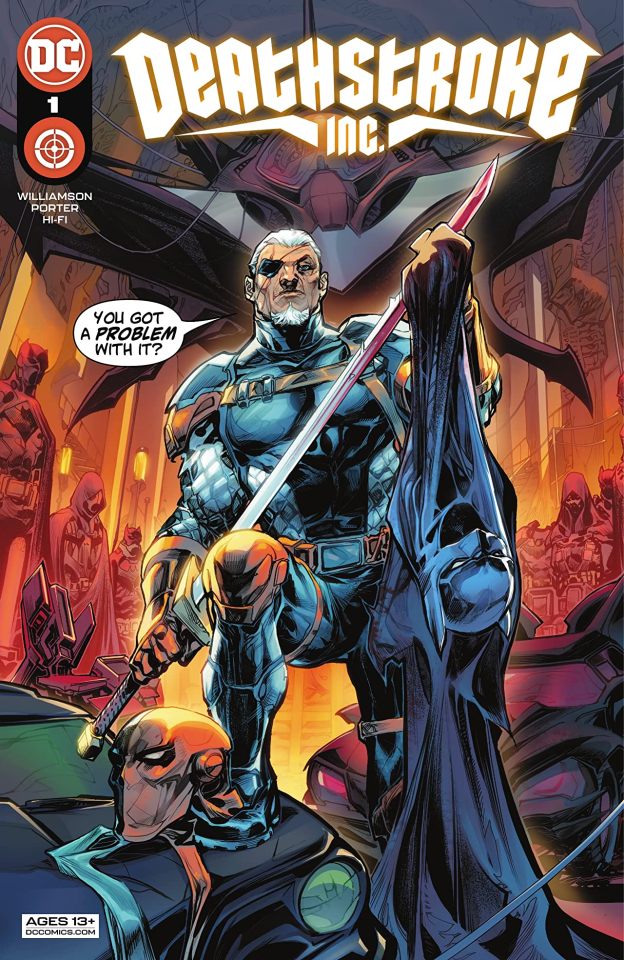
Deathstroke Inc. #1
DC Comics 2021
Written by Joshua Williamson
Illustrated by Howard Porter
Coloured by Hi-Fi
Lettered by Steve Wands
After suffering too many losses, Slade Wilson decides it’s time for a change. When he’s enlisted to work with an ages-old secret organization called T.R.U.S.T. who want to take down the heavy-hitter villains, he’s all in. They’ll supply him with an all-new team and resources for his new mission into the depths of the weirdest parts of the DCU, including a new partner…Black Canary! Wait what?! Enjoy explosions, kick-ass action, and new outrageous adventures as DC’s meanest S.O.B. gets tangled up in a major mystery building in the shadows of the DCU.
Okay colour me intrigued and here for the long haul. I was a little worried with the title of the book, which is both on trend and yet misleading but that’s okay it’s all done for the popularity of the character. Now I’ve not heard of this organisation before and since Checkmate I have been saying we need to see more of these spy type organisations though this feels like a shadowy one without the spy aspect more like a direct assault on super villain bases with an even more ambiguous leader with their own agenda and I can’t wait to see how T.R.U.S.T. is exposed for what it really is.
I like the way that this is being told. The story & plot development that we see through how the sequence of events unfold as well as how the reader learns information is presented exceptionally well. The character development we see through the dialogue, the character interaction as well as how they act and react to the situations and circumstances which they encounter really brings their personalities to the forefront. The pacing is excellent and as it introduces us to the story, the characters and their niche in this world it raises more questions as it intrigues the reader.
I like how we see this being structured and how we see the layers within the story begin to emerge and grow. Joshua is good at this too because the avenues that are opened up here are fantastic and they add this wonderful depth, dimension and complexity to the story. He understands how to write characters who do, don’t or won’t cross certain lines and yet make it come damn close to it. Everything works together to create the story’s ebb & flow as well as moving the story forward exceptionally well.
The interiors are nice. The linework we see really has some great flow to it and thanks to the varying weights and techniques the detail we see within the work really stands out nicely. Backgrounds are utilised fairly well, we could always see more of them in use, as they enhance and expand the moments as well as work within the composition of the panels to bring out the depth perception, sense of scale and the overall sense of size and scope to the story. The utilisation of the page layouts and how we see the angles and perspective in the panels show a strong, talented eye for storytelling. The various hues and tones within the colours being utilised to create the shading, highlights and shadow work show a great understanding of how colour works.
One thing I will say is that I doubt Batman would let this organisation anywhere near his gear and technology, so regardless of Hiro I question this aspect of the story. Even with his current state of mind I’m not buying it 100% so I wanna see Bats either come after them or Hiro and see what the whole deal with this is really about. This has some great strong writing and on point characterisation along with this great classic comic book style interior that makes for a fun, interesting and intriguing read.
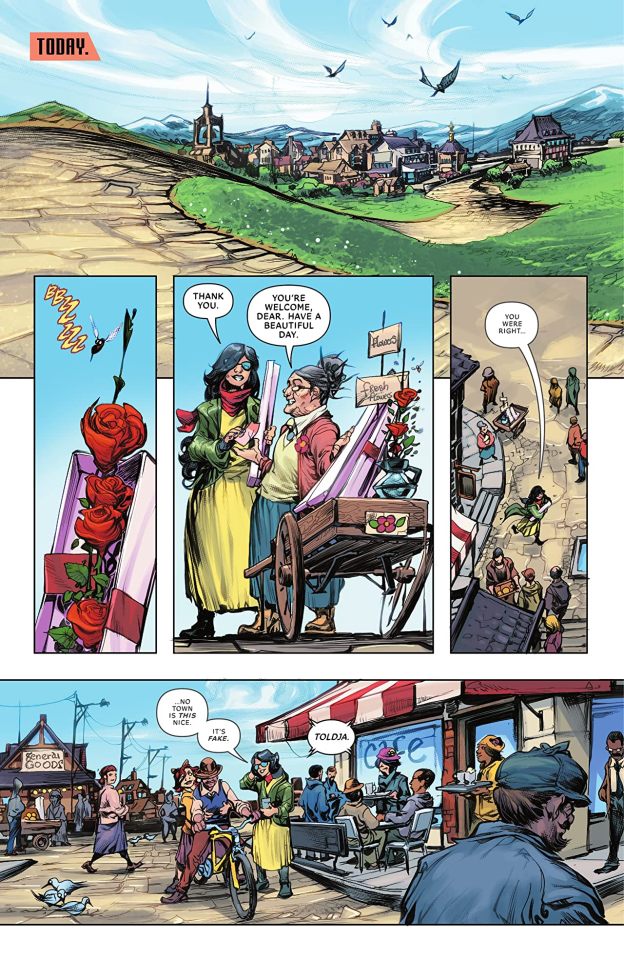
0 notes
Photo

For the week of 13 November 2017
Quick Bits:
Babyteeth #6 opens the floodgates of story after getting through the initial hurdle of getting Sadie and Clark out of imminent danger. Donny Cates gives us more depth as to what’s going on broader picture of the world and introduces us to the cult geared to protecting and raising Clark.
| Published by AfterShock



Black Science #33 has the shit hit the fan as the confrontation between Grant and Kadir reaches its peak and then reality breaks. The mix of mad science and philosophy from Rick Remender on display here is wonderful, seeing a representation of Platonic ideals mapped onto quantum realities in a kind of unfurling of Gnostic cosmology is impressive. So too is Matteo Scalera’s art. He and Moreno Diniso really get to cut loose this issue and it looks wonderful.
| Published by Image / Giant Generator

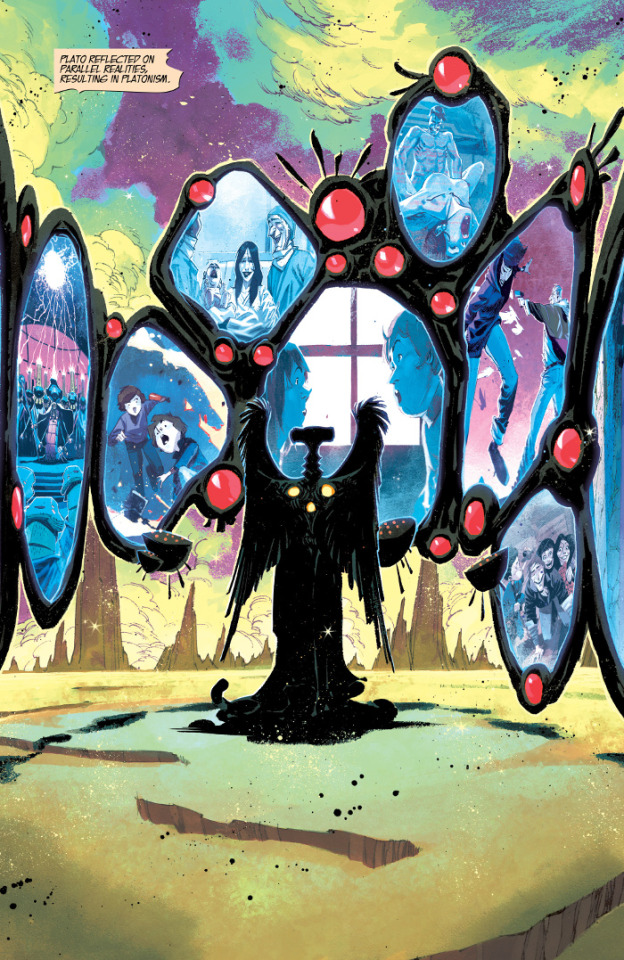

Bloodshot Salvation #3 gives a revelation to the “soon” timeline of what’s happened to Ray, while in the “now” we get a confrontation between Ray and Daddy, Colin King helping out Magic, and Project Omen causing complications. I probably sound like a broken record, but Jeff Lemire, Lewis LaRosa, and Mico Suayan are doing some great things with this series.
| Published by Valiant

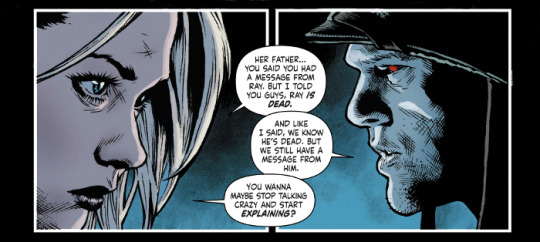

Brilliant Trash #1 is an interesting take on superheroes. It’s a mix of government conspiracy and potentially mad science, told from the perspective of a journalist looking for a story in the appearance of a V-like figure, Lady Lastword’s, final speech and death. Tim Seely’s got something interesting here. Priscilla Petraites’ art is also quite nice, kind of a mix between Jamie McKelvie and Phil Hester.
| Published by AfterShock



Dark Fang #1 continues the trend of not naming the protagonist in the body of the first issue. The solicitation copy and end piece are what’s needed to piece together the full premise of the series and name of the protagonist. That said, Miles Gunter does have a decent story here. It’s environmentalism through the lens of a centenarian vampire, Valla, who was friends with a fish until modern industry destroyed her ecosystem. But first, earning money as a cam girl and getting caught up in society’s obsession with cell phones and the internet. The art from Kelsey Shannon is a definite plus.
| Published by Image



Deadpool vs. Old Man Logan #2 is every bit as fun, humorous, and action-packed as the first issue. Declan Shalvey has a great feel for both Wade and Logan and Mike Henderson’s art is truly wonderful. Only two issues in and this is just a fun, must-have wild ride.
| Published by Marvel

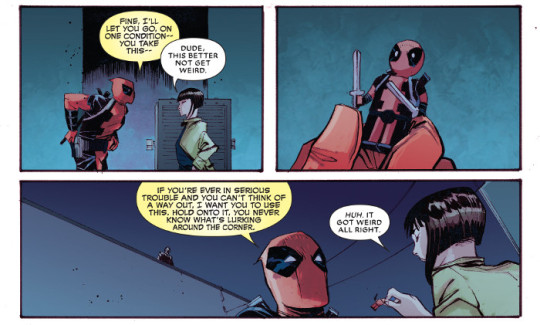

Evolution #1 is a very strong debut issue with multiple voices brought together by the singular visuals of Joe Infurnari. Infurnari has a style that is a bit Tom Mandrake and a bit Bill Sienkiewicz and it is absolutely perfect. If you like David Cronenberg’s early horror films, even just a little bit, you owe it to yourself to at least check this out.
| Published by Image / Skybound

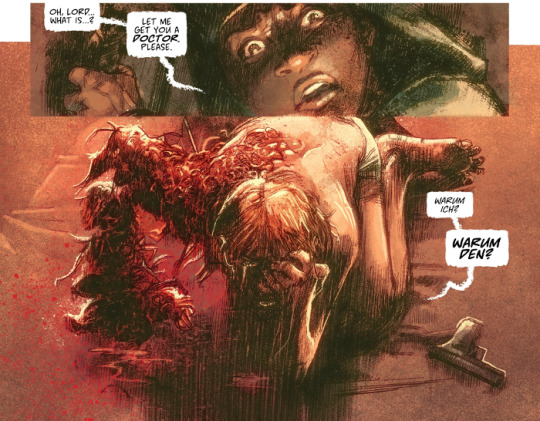

The Family Trade #2 continues Jessa’s investigations into Berghardt and Mikkaelsen despite the protestation and outright prohibition by her Family. Her technique of getting close by blending in as a simple cleaning woman is a nice touch. The end, though, suffers a bit in who exactly Jessa is speaking to. I think it’s supposed to be her uncle, but I’m not sure.
| Published by Image



Fence #1 gives me the impression that everyone, even the protagonist, involved in competitive fencing is an asshole. That’s not necessarily a good impression of the sport, and gives a poor outlook on who to “cheer” for in the endeavour, but it may be an accurate depiction. Especially since many sports seem to be populated by jerks.
| Published by BOOM! Entertainment / Boom! Box



Generation Gone #5 is a suitably insane conclusion to the first arc of this series. It’s violent, angry, and explosive - kind of like how you’d expect kids to react when they find out that the world is designed to see them fail. André Lima Araújo’s art has just been fantastic on this series.
| Published by Image

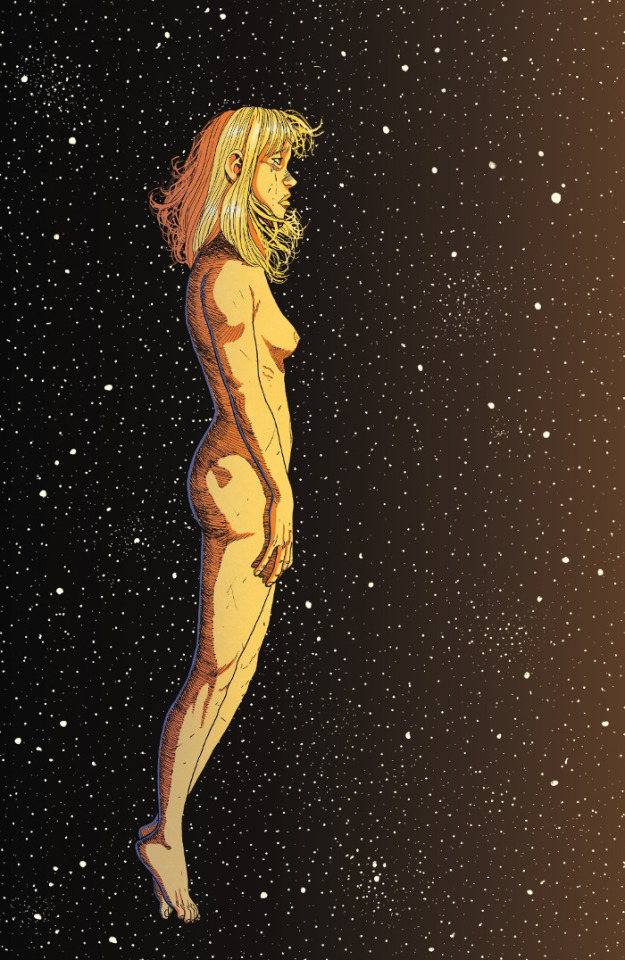

Hawkeye #12 is a team-up issue between Kate and Laura (All-New Wolverine) with Gabby and Jonathan in tow as well, illustrated by guest artist Michael Walsh who is easily proving he’s a force to contend with. This issue looks great and is fun as hell.
| Published by Marvel

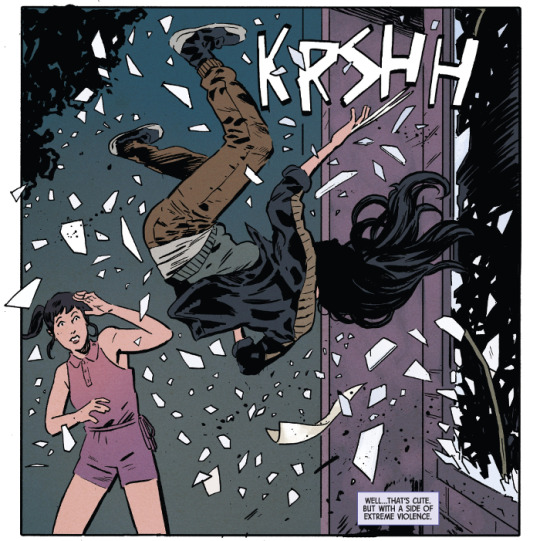

Jenny Finn #1 now in colour. If you haven’t read this masterpiece of Lovecraftian lit from Mike Mignola and Troy Nixey before, now’s a good time to do so. If you have, especially since this has been reprinted and repackaged a few times before, you’ll have to decide whether or not you want Dave Stewart’s colour. There was something to be said for the original black and white, although the colour version’s not bad.
| Published by Dark Horse

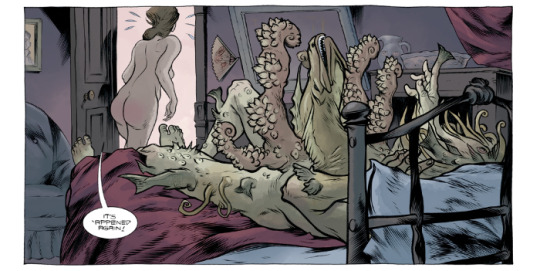

Kill the Minotaur #6 is both an expected and unexpected conclusion to the series. Ariadne and Theseus’ confrontation of the Minotaur is suitably epic. I can’t say much more than that because they’d be massive spoilers, so enjoy this amazing artwork from Lukas Ketner.
| Published by Image / Skybound



Killer Instinct #2 does what I was afraid the first issue was going to do and dumps a lot of characters with intricate backstories from the game on us in one go. Where the first issue mainly focused on one character to ease us into the world, this issue gives us more of the Coven, a bunch of characters fighting over the Killer Instinct Tournament, and Jago. While the Jago and Tsar bits are fairly well executed, the central bit over Ultratech is a bit of sludge. As I said in response to the first issue, I’ve never played the game and know little about the world, so this felt a bit like being dropped right in the deep end. The art from Cam Adams is still nice, though.
| Published by Dynamite



Maestros #2 quickly installs Will as the new Maestro and he begins making sweeping changes to the multiverse’s society, trying to bring concepts like equality and freedom to a world that only seems to know subjugation under magical will. It’s an interesting exploration of sociopolitical ideas from Steve Skroce and naturally it brings about severe pushback from those previously in charge. And betrayal.
| Published by Image



Mech Cadet Yu #4 features the cadets first full on confrontation with the Sharg and it’s about as exciting as you would expect. Takeshi Miyazawa’s art is just wonderful and it’s really nice to see Yu thinking on his feet during the battle to ensure the continued survival of the entire team.
| Published by BOOM! Studios



Minky Woodcock: The Girl Who Handcuffed Houdini #1 is interesting. The relationship between Harry Houdini and Sir Arthur Conan Doyle has certainly been in the zeitgeist lately, this one doing something different and focusing on the end of Houdini’s career, long since the two had their falling out. Cynthia von Buhler sets up Minky looking into Houdini debunking spiritualists at the request of Doyle fairly well, but the main enticement is von Buhler’s art. She has a style that reminds me a bit of Melinda Gebbie and it works incredibly well for the smoky, pulpy atmosphere of the story.
| Published by Titan / Hard Case Crime

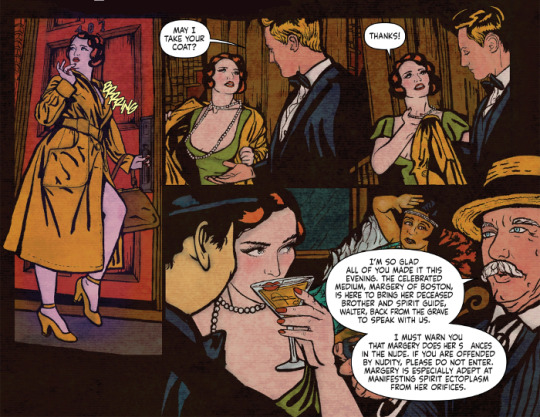

Misfit City #7 lines up the dominoes in this penultimate issue. Overall this has been a great series and I’m excited to see how it ends. That being said, I wish there were more. The world needs more girl adventurer books and this one has been excellent.
| Published by BOOM! Entertainment / Boom! Box

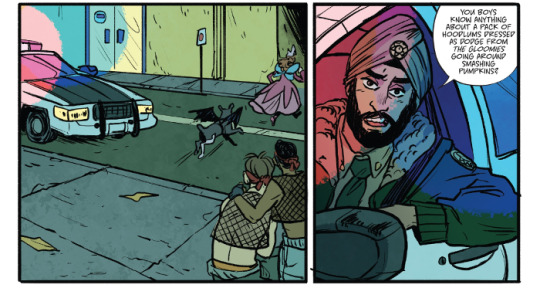

Ninja-K #1 is a damn fine new direction for Colin King, looking deep into the past of the Programme, dealing with the history of Ninjas A through L, and putting forth a mystery as to who killed Ninja-D and appears to be targeting the other remaining operatives. Christos Gage gives us a compelling mix of mystery and spy thriller that’s only topped by Tomás Giorello’s incredible artwork. Damn fine work.
| Published by Valiant

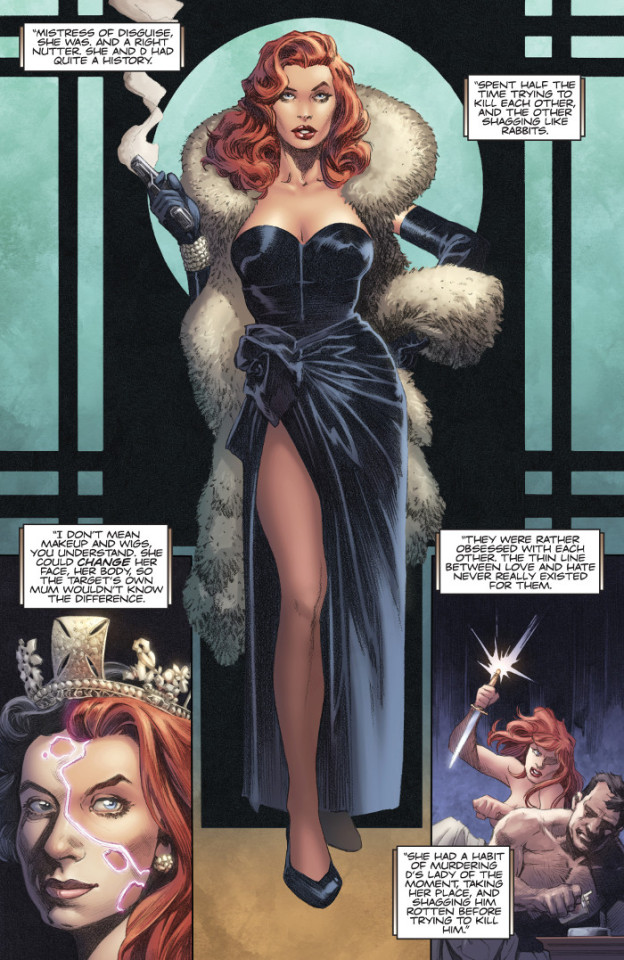

Rasputin: The Voice of the Dragon #1 begins another pre-Hellboy, pre-BPRD series tying numerous disparate threads together and giving more backstory on the world. This first issue focuses more on Trevor Bruttenholm tracking down a decrypted Nazi message, but it could be about a talking head describing how to prepare an avocado because Christopher Mitten makes everything look amazing. Thankfully, though, the story isn’t bad either.
| Published by Dark Horse

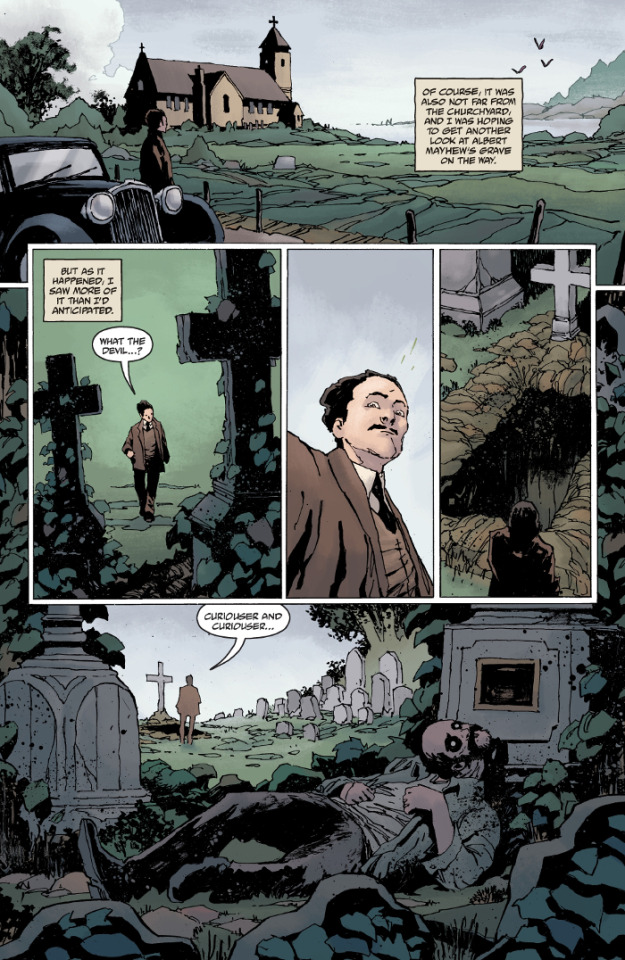

The Realm #3 reveals some chinks in the baddies’ armour as strong personalities clash. The artwork from Jeremy Haun is again one of the main drawing factors. This series just looks great.
| Published by Image



Retcon #3 finally gets around to the premise that Matt Nixon and Toby Cypress were on about in the interview in the first issue. I’m thinking maybe for a storytelling point, they should have led with this, but it does give the series a better cohesion and purpose. This was the make or break issue for me and Crowley ripped from time to tattoo a baby won me over.
| Published by Image



Star Wars: Darth Vader #8 continues Jocasta Nu’s infiltration of the Jedi Archive to retrieve an artifact from under the nose of the Grand Inquisitor. This issue gets a little...explosive.
| Published by Marvel



Star Wars: Doctor Aphra #14 is Emilio Laiso’s debut on the comic and the artwork looks gorgeous. He did a great job on the Rogue One adaptation and it’s nice to see him back on a Star Wars title. Even if I’m going to miss the hell out of Kev Walker’s art.
| Published by Marvel

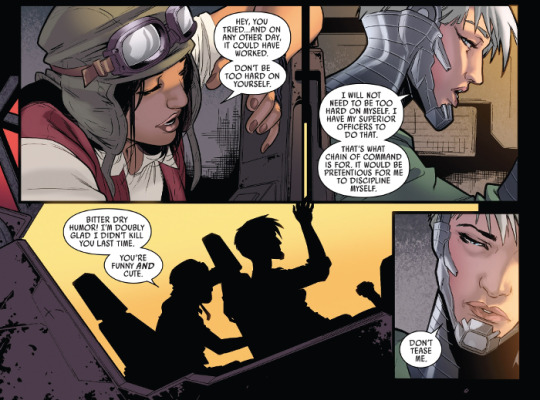

Teenage Mutant Ninja Turtles #76 allows no rest for the turtles as they return home from Dimension X, also after the brief excursion with the Ghostbusters. Damian Courciero looks like he’s handling the art chores for this arc and it’s a welcome addition. He has a darker, somewhat more realistic style and it suits the chaos and destruction going on with the Earth Protection Force’s first contact with the Triceratons.
| Published by IDW



Unholy Grail #4 continues this dark and twisted retelling of the Arthurian legend. Part of what really works about this series, though, is that it really isn’t that far removed from the other stories of glorious knights and magic, just given a different context,
| Published by AfterShock



Other Highlights: Adrift, Alien Bounty Hunter #2, Amazing Spider-Man #791, Ben Reilly: Scarlet Spider #10, Bolivar, Champions #14, Curse Words #10, Defenders #7, Descender #26, Doctor Strange #381, Dreadful Beauty: The Art of Providence, East of West #33, Guardians of the Galaxy #147, Horizon #16, Incidentals #4, Incredible Hulk #710, James Bond: Kill Chain #5, Mage: The Hero Denied #4, Mighty Thor #701, Not Brand Echh #14, Peter Parker: The Spectacular Spider-Man #297, Postal #24, Punisher #218, Ringside #13, Secret Warriors #8, Sheena: Queen of the Jungle #3, TMNT/Ghostbusters 2 #3, The Wicked & The Divine #33, X-Men Blue #15, Zojaqan #2
Recommended Collections: Ab Irato, Goldie Vance - Volume 3, James Bond - Volume 1: Vargr, Journey to Star Wars: The Last Jedi - Star Wars: Captain Phasma, Luke Cage - Volume 1: Sins of the Father, Nancy Drew & The Hardy Boys: The Big Lie, Regression - Volume 1: Way Down Deep, Rough Riders - Volume 2: Riders on the Storm, Star Wars: Poe Dameron - Volume 3: Legends Lost, World Reader - Volume 1

d. emerson eddy knows that evolution is a mystery, full of change that no one sees. He sees the line in the sand.
3 notes
·
View notes